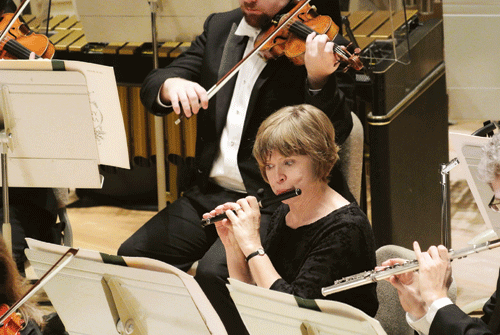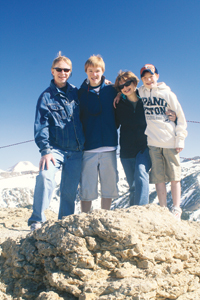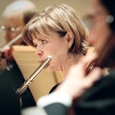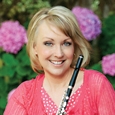.gif) Cynthia Myers joined the Boston Symphony Orchestra as principal piccolo in the fall of 2006. Previously she was principal piccolo of the Houston Symphony for nine years and prior to that principal flutist of the Omaha Symphony for nine seasons. She has also performed with the Minnesota Orchestra, Chicago Symphony, and the Grand Teton Music Festival Orchestra.
Cynthia Myers joined the Boston Symphony Orchestra as principal piccolo in the fall of 2006. Previously she was principal piccolo of the Houston Symphony for nine years and prior to that principal flutist of the Omaha Symphony for nine seasons. She has also performed with the Minnesota Orchestra, Chicago Symphony, and the Grand Teton Music Festival Orchestra.
How did you begin studying music?
I began playing piano at the age of three mainly because my sister, who is 15 years my senior, was a wonderful pianist and I idolized her. My first musical memories are of sitting on the piano bench and listening to her play Debussy. I don’t really remember a time that I did not want to be a musician. When my mother told me there was such a thing as a music major in college, I decided that was for me, though I had no idea what that really meant. When I was six, I started formal lessons on piano and continued until my sophomore year in college. I believe it is essential for all musicians to have at least a basic knowledge of keyboard as it is so helpful with note-reading during early studies and with theory and score reading later on.
I began playing flute in the 4th grade in my school band program. Actually, my first choice was the oboe; however studying the oboe was not an option in my very small elementary school in western Pennsylvania. I was terrible at the flute. In fact, I distinctly remember the elementary school band director telling me that I would never be able to master the instrument. It was not until the 8th grade that I found a private flute teacher, Vicki McDowell, who was the wife of the new high school band director. She also played the piccolo in the Johnstown Symphony. It was an eye opening experience to have someone finally explain how to make a decent sound on the flute. She introduced me to Taffanel & Gaubert, Handel Sonatas, Anderson etudes and later, the French repertoire. I was hooked, and piano became something I did to supplement the flute.
In my junior year, she decided it was time for me to move on and sent me to Pittsburgh to study with Bernard Goldberg. He was very tough. Goldberg introduced me to the Moyse Tone Development Through Interpretation. I will never forget his colorful explanation of those pieces.
What were your college experiences?
In college I studied for the first two years with Ethan Stang, Pittsburgh Symphony piccolo, at Carnegie-Mellon in Pittsburgh. Ironically, we never worked on any piccolo during the time I studied with him. His main emphasis was on basic flute skills. We spent a lot of time on Taffanel & Gaubert and Anderson etudes. In the spring semester of my sophomore year, Stang left the school, and I called Julia Bogorad, the principal flutist of the St. Paul Chamber Orchestra, to set up a lesson while I was vacationing with my family in the Grand Teton National Park. Bogorad was playing with the Grand Teton Music Festival (GTMF) and made the time to hear me play. I will never forget the experience. We spent over two hours on Moyse De La Sonorite. I think at least 45 minutes was spent just on playing a B natural with beautiful sound. She opened up an entirely new world for me, and I spent the rest of that year putting into practice what I had learned in that lesson about using my air correctly as well as the correct form of my embouchure. I was fortunate to take another lesson with her again on a trip to St. Paul, and I had the opportunity to work more closely with her when I was a student at the GTMF Student Orchestral Seminar.
After working with her, I contacted Jeffrey Khaner, who at that time was the principal flutist of the Cleveland Orchestra and flute professor at the Cleveland Institute of Music, and asked if he would have time to give me a lesson. I should say that Khaner had heard me a year before and had not been impressed with my playing. I think it was the only time anyone had ever given me a C+ on a jury. So, when I called him, he was somewhat reluctant to hear me play. However, when I finished playing a bit of the Martinu Sonata for him, he stopped me and asked, “What did you do between now and the last time I heard you?” to which I replied, “I took two lessons with Julie Bogorad.” He was pleased to hear the changes that I had made in my playing and agreed to take me on as a student. For two years, I commuted from Pittsburgh to Cleveland every other week to take lessons with him. Those years were really the beginning of my career. I ended up doing my Master’s degree with Khaner at the Cleveland Institute of Music. He was able to refine my technique and constantly challenged me to learn new and more difficult repertoire. During the four years I spent in Cleveland, I also played in both the Akron and Canton Symphonies.
I think the most important thing that my flute teachers gave me was a strong base on which to build my piccolo skills. If not for Khaner, I would have never been introduced to William Hebert, my first piccolo teacher. As students at CIM, we had cheap tickets to The Cleveland Orchestra concerts, and we did everything we possibly could to hear them play as many times as possible during the week. It wasn’t unusual for us to hear the same concert two or three times. There was one concert in particular that changed my life. The orchestra program was Ravel’s Mother Goose, Shostakovich Cello Concerto No. 1 with YoYo Ma, and Ravel’s Daphnis et Chloe. I was so enthralled with Hebert’s playing that I ran backstage to catch him before he left, but sadly missed him. Soon after that a piccolo job came open in the North Carolina Symphony. I talked to Khaner about taking the audition, and he very wisely told me to call Bill Hebert. I did and the rest, as they say, is history. I remember leaving my first piccolo lesson filled with so much information; I thought I would burst with excitement. I made the finals in the North Carolina audition and was hooked on piccolo. I studied with Hebert for the next two years, and even long after I left Cleveland, I made the trip back for brush-up lessons.
I used to joke with him that his lessons were like going to the doctor because he is such a great diagnostician. I would come in with a problem that had come up during practice, and he would say, “let’s take out Taffanel #10, diminuendo to the top, crescendo to the bottom.” In a few minutes, he was able to diagnose the problem and find the best way to address it. If one thing didn’t work, he would help me find another. He also gave me the tools to help me heal myself; this was one of the many great gifts I received while studying with him. He also passed on the great tradition that was the Cleveland Orchestra of the Szell era, particularly in the aspect of rhythm and phrasing. The last lesson I had with him was in 2006, right before the BSO audition. I still go back over my notebook and lesson recordings for inspiration.
What were your orchestral experiences in Omaha, Houston, and Boston?

I have loved every place that I have had the privilege to play. All of these orchestras have great things about them, yet each is very different. I won the principal flute position of the Omaha Symphony in 1988 when I was in the thick of taking many piccolo auditions. At the time, I couldn’t afford, literally, to be picky about piccolo versus flute jobs, so I took any and every audition that came along. I never pictured myself living anywhere west of the Mississippi, let alone in Nebraska, but I knew this was a good orchestra. I was lucky enough to win the audition and spent nine wonderful years there. It was a very tough 38-week schedule, but we played a great diversity of music. One week we would play chamber orchestra, and the next would be full-orchestra repertoire. Other concerts included pops, opera or ballet and then there was the woodwind quintet that was made up of the principal winds of the orchestra. We played dozens of children’s concerts a year and learned how to put together an educational show and speak to an audience. I met my husband, Steve Laven, who was the principal cellist, and had my first son while we were there. When I left Omaha to go to Houston, many musicians made the comment that I must have been glad to move on. Actually, the only reason I left was because I was a closet piccolo player at heart!
In going to the Houston Symphony in 1997, I achieved a goal that I had been working toward since I met Bill Hebert. The experience of playing in that orchestra was incredible. At the time Christoph Eschenbach was on the podium, and the wind section played like a single unit. My three colleagues in the flute section quickly became three of my dearest friends.
When I began my job as the piccolo player of the Houston Symphony, I started with a European tour. Now, by this time I had considerable experience in orchestral playing, but as a principal flutist, not as a piccolo player, so I was quite green and extremely nervous. One of the pieces was Mahler Symphony No. 1, and I spent hours working on playing the opening measures to get it exactly right – in tune, soft with beautiful legato. I arrived at the first rehearsal and after the orchestra tuned, Maestro Eschenbach warmly introduced me and welcomed me to the orchestra. We then began the first movement of the Mahler. I was so nervous, I promptly started the piece on an A flat rather than an A. Needless to say, I was mortified. Eschenbach was very gracious and joked “Well, now that we have that out of the way, let’s begin again.” We played the Mahler at Tanglewood a couple of years ago with Christoph Eschenbach on the podium and he remembered (fondly) those fateful first moments in my new piccolo career.
The Houston schedule was busy, but much more predictable than Omaha. I was there for nine years and thought, at the age of 43, that I was done with auditions. When the Boston piccolo audition was announced, however, my husband suggested that I should go. I had made the finals back in 1990, and it might be fun to try again. Fun is not exactly how I would describe preparing for that audition with two young sons and a full time job. Just to play in that hall one last time would make the trip worth the effort, however, so I decided to try. I made a trip to Cleveland to play for my teacher and looked at the audition as a way to challenge myself.
I was thrilled to win the job, and my section here is very special. In fact, I have been very lucky in all three orchestras to work with amazing colleagues. The Boston Symphony Orchestra schedule is one of the most difficult I have encountered, especially at Tanglewood where we play three different programs a week with very little rehearsal time. It is very rewarding and difficult work at times, but to do it in such a beautiful place makes it quite special. I feel that way about Symphony Hall as well. There are times that I quite literally have to pinch myself to believe that I am here, working with amazing musicians and conductors whom I have admired all of my professional life.
 What is your teaching philosophy?
What is your teaching philosophy?
I love teaching and passing along the information that has been given to me over the years. When I was in Omaha, I did quite a bit of teaching, but due to the BSO’s demanding schedule, I have limited time to teach now and also want to spend as much time as I can with our two teenage boys. I feel strongly that teachers should help students find a good balance in using their practice time. I insist that my students do tone studies, usually Moyse De La Sonorite; however, I find Trevor Wye’s Tone Book a very good resource as well. Moyse’s Tone Development Through Interpretation and 24 Petite Etudes, the Taffanel et Gaubert 17 Daily Studies and Andersen etudes are all very important components. When I was a student, I set up my practicing somewhat like this: tone studies, technical exercises and etudes, finishing with pieces or excerpts.
On piccolo, I found that much will cross over. Taffanel is very important for working on an even sound and intonation through all registers. I love the “Aquarium” exercise in Trevor Wye’s book. This is such an important study for intonation – really listening to the width of intervals – as well as a way to work on smooth legato. Hebert suggested that I work on the Ferling Studies for oboe and they are great on the piccolo. Some passages need to be reworked for the octave differences, but they are wonderful little pieces that cover every key and difficulty on the instrument.
I don’t stress the piccolo in lessons. In fact, I don’t like to teach a young player only piccolo because so much is dependent upon the basic skill of playing the flute. However, it would be silly for someone to study flute with me and not have some amount of piccolo lessons, so I break the time up with approximately 3/4 flute and 1/4 piccolo. I do have students who will regularly coach piccolo with me in the months leading up to an audition. I stress that having ample time to become comfortable on the instrument is very important. I always find it a bit funny that two weeks before an audition, I will get rather panicked phone calls from students who want me to teach them the instrument in two weeks or less. It really doesn’t work that way.
Do you have any unusual audition experiences?
My life had undergone significant changes compared to the last time I made the finals for the BSO in 1990. With two young sons and a full time job, I simply didn’t have the same amount of time to prepare for an audition. Since I could not sacrifice my family responsibilities or my job, something had to give in the audition preparation and Semiramide simply didn’t get the attention that it needed. Of course it was the last piece on the semi-final round. I played the required section, and it did not go very well. From the other side of the screen, I heard a voice kindly ask if I could do it again, a bit slower. I did. Then the same voice asked if I could do it again a bit shorter. I did and that was the end of the round. The Semiramide excerpt came up again in the next two rounds and each time, I was sure to play it a bit slower and a bit shorter. Had the committee not asked me to play the excerpt again, I would not have had the chance to prove that I had the ability to change and be flexible, not to mention the ability to fix what was wrong.
***
A Piccolo Practice Routine
My practice routine on the piccolo really doesn’t differ that much from what I do on the flute. I begin with tone studies – either De La Sonorite or The Aquarium exercise in Trevor Wye’s Tone Book. Then it is important to warm up the fingers, so spending time on Taffanel et Gaubert, or the equivalent is essential. I find #10 particularly helpful. I begin forte and then diminuendo to the top and crescendo as the line comes back down to the low register, concentrating on the speed of air and support from the diaphragm. I also like to work on etudes – Anderson Op. 33 and 63 are two favorite books. The studies by Ferling for oboe and saxophone are wonderful little pieces for the piccolo. Some of them have to be transposed to a different octave, but mostly, these etudes lie well on the instrument and are great for working on technique, sound and intonation. They are also good pieces for practicing any alternate fingerings that you might want to become more adept at using.
Doing all of this preliminary work is similar to entering information into the hard drive of a computer. When the time comes to access this information in repertoire, the work has already been done, so the fingers and the embouchure can function smoothly. Then we can take the time to really think about the intricacies of the music, rather than worry about the technique.






